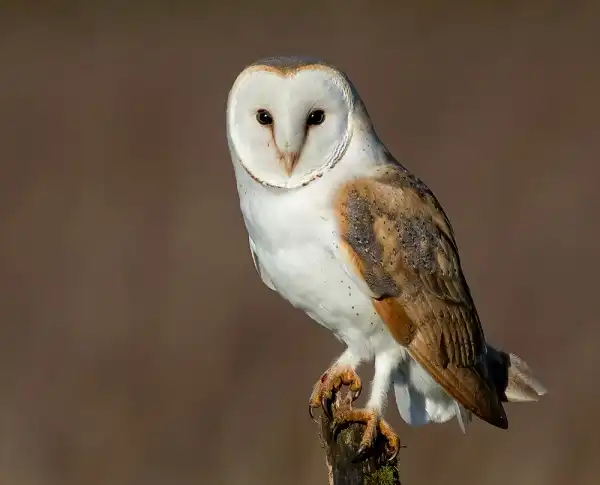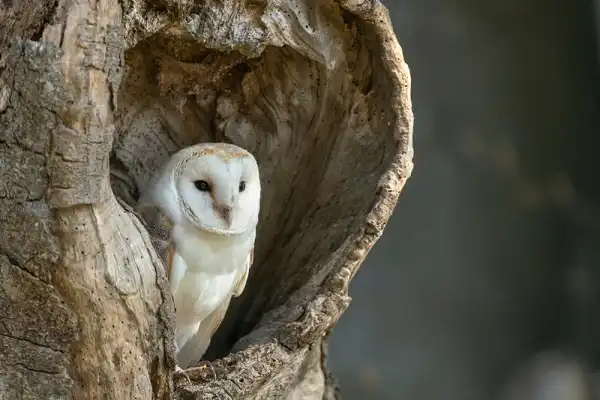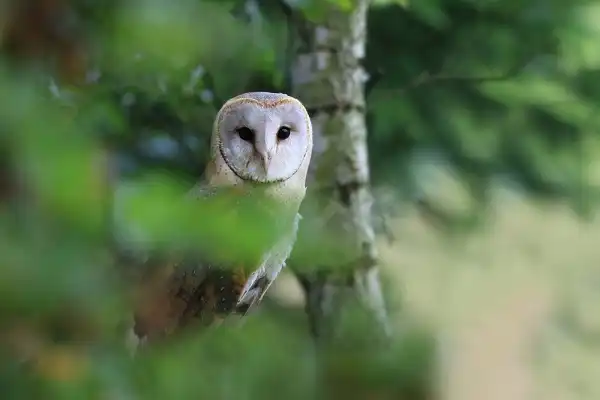The barn owl is a nocturnal bird. Although it is most active at night. These birds are often seen flying low over fields or farmland in search of their next meal. Thanks to their exceptional hearing, they are able to locate these animals even in complete darkness. If you’re lucky enough to spot a barn owl while out on a nature walk, you’re sure to be impressed by its beauty and grace. Keep your eyes peeled for this magnificent bird the next time you venture into the great outdoors!

Barn Owl Description
The Barn Owl is a beautiful, graceful bird of prey that can be found in many parts of the world. It has an iconic heart-shaped face and a long, curved beak. The upper parts are typically pale or tawny brown in color, while the underparts are white to buff-colored. It has large eyes that are yellowish-white in color and long pointed wings. Its tail is short and rounded, giving it an overall owl-like appearance. It’s not unusual for Barn Owls to be seen flying during the day as well as at night. During daylight hours they may roost on branches of trees or high atop buildings which gives them a great view over their hunting grounds below them. Their call is a shrill screech that carries far across the countryside – it’s sure to catch your attention when you hear it!
Barn Owl Habitat
The Barn Owl is an incredibly adaptable species that can be found in a wide variety of habitats, from deserts to forests and even suburban areas. In fact, they are one of the most widely distributed birds of prey around the world. They can be found in Europe, Africa, Asia, Australia, and New Zealand as well as North America. Barn Owls prefer habitats with plenty of open areas such as pastures or grasslands. They usually roost high up in large trees or barns or haystacks during the day, while they hunt over these open areas at night. They often live near rivers and streams as they provide a consistent source of food with small mammals such as mice and voles living around them. Barn Owls nest in cavities such as tree hollows or old buildings and will use any materials available to line the inside for insulation – this includes feathers which are particularly useful for keeping the eggs warm until hatching. They may build their own nests if no suitable cavities are available, however, this is far less common than nesting in a ready-made structure.
Barn Owl Diet
The Barn Owl’s diet consists of a wide range of small animals and birds, which can often vary depending on the region that they inhabit. The most common prey for these birds are rodents such as mice, voles, shrews, and bats. As well as small mammals, they may also feed on lizards, frogs, insects, and even other birds like swallows and sparrows. Their diet is not only reliant on what prey is available in their environment but also on when it is available. During winter months they tend to eat larger animals like rabbits as smaller mammals become scarcer due to snow cover preventing them from scavenging for food. During summer months, however, their diet changes focus on smaller prey such as mice and beetles which are more plentiful during this time of year.
Also due to their adaptable nature, Barn Owls can take advantage of new sources of food that humans create for them – such as fields planted with grains or crops – allowing them access to an abundance of small vermin that may be attracted to these areas looking for food themselves! In order to supplement their diet with vitamins and minerals, Barn Owls will also consume carrion or invertebrates such as snails or earthworms – particularly during late spring when chicks need extra nutrients while growing up before leaving the nest.

Barn Owl Size
The Barn Owl is a medium-sized bird of prey, measuring between 30 to 40 cm or 12 to 16 inches in length. On average it has a wingspan of up to 1 meter or 3 feet 2 inches. Their distinctive long legs are relatively short for an owl species, but their sharp talons are still powerful enough to clutch onto small animals for prey. They also have a long tail and tufts of feathers on the head which are used mainly for camouflage when hunting during the night. While the male and female look very similar, the female Barn Owls tend to be slightly larger than their male counterparts and can weigh up to 550 g or 19 oz – this is roughly half the weight of an adult Bald Eagle! However, as with most bird species, juveniles lack the typical markings found on adults with much lighter coloration making them harder to spot until they reach maturity.
Barn Owl Lifespan
Barn Owls typically have a long lifespan, with many individuals living up to 10-15 years in the wild and potentially even longer in captivity. The oldest known wild Barn Owl was over 20 years old when it was found dead! This is thanks to their adaptable nature and varied diet which helps them survive in a wide range of habitats. The factors that influence an owl’s lifespan include its ability to find food, its access to shelter, and the availability of mates for reproduction. Barn Owls are monogamous birds, meaning they usually stick with one mate for life and will likely attempt to breed every year – making successful reproduction important for long-term survival.
Additionally, Barn Owls will also benefit from having a safe place to nest or roost either in trees or on buildings as well as good sources of food nearby. In addition, young Barn Owls experience high mortality rates as they are more vulnerable than adults due to inexperience and lack of protection from predators. Although some may survive their first year or two, the average life expectancy for juveniles is between 2-4 years of age if they can make it past this stage.
Barn Owl Behavior
Barn Owls have a distinct call that sounds like a long drawn-out ‘screech’ or shriek that is used to both defend their territory and attract a mate. They are also known to make a hissing sound when disturbed or threatened. Compared to other owl species, Barn Owls are quite solitary birds living alone outside of breeding season. However, during breeding season males may congregate around potential mates who then choose one partner based on how attractive he appears – offering food or singing could help him stand out from the crowd! With its wide distribution range, adaptability, and long lifespan – it’s easy to understand why the Barn Owl has become so popular amongst bird enthusiasts all over the world!

Barn Owl Speed
Barn Owls are renowned for their impressive flying skills and speeds, capable of reaching up to 30-60 mph (48-97 kph) in horizontal flight. This gives them the capability of covering large expanses of land quickly, making them one of the fastest animals in the sky. In addition to speed, Barn Owls can change course rapidly and sharply, using their lightweight bodies and long wingspan to maneuver through tight spaces with ease. The anatomy of their wings also plays an important role in helping them reach such speeds. Their wide wings are equipped with special feathers that form a smooth surface over the leading edge, allowing them to cut through the air without generating too much drag or turbulence. At the same time, their feathers act as natural sound dampeners which reduce wind noise – making it possible for them to swoop down on unsuspecting prey undetected! When soaring above an area looking for food or shelter, Barn Owls are capable of reaching altitudes up to 2000 ft (610 m), giving them an impressive view from high up above ground.
Barn Owl Hunting
Barn Owls are highly adaptable predators, able to hunt in a variety of different habitats including grasslands, forests, wetlands, and even urban areas. To locate their prey they rely on both sight and sound; using their powerful hearing to pinpoint the location of small animals like rodents and other invertebrates before swooping down at lightning speed with their sharp talons extended! When hunting, Barn Owls use a strategy similar to all birds of prey – flying in wide circles over an area looking for any movements that could indicate a potential meal. Once detected the owl will drop from the sky silently and approach its target from below or behind where it is less likely to be seen. This is because Barn Owls have adapted to hunt at night or during low light conditions when visibility is poor so they must compensate by relying on their excellent vision and acute hearing in order to spot their prey.
This combination of speed, agility, stealth, and binocular vision gives Barn Owls an edge over other birds of prey when it comes to hunting; allowing them to successfully capture larger game as well as smaller animals like mice and insects which make up the bulk of their diet! In addition, they often hunt cooperatively with other owls or even members of their own species working together as a team for better results! In terms of range and versatility, Barn Owls are hard to beat – capable of hunting in almost any environment from open fields to dense woodlands or even urban areas. Their impressive vision also allows them to detect movements from far away making it possible for them to cover large distances quickly in search of food or shelter.

Conclusion
The Barn Owl is an extraordinary creature with unique adaptations that allow it to hunt and survive in a variety of different environments. From their powerful vision and acute hearing to their superior speed and agility – these amazing birds have the perfect blend of attributes necessary for hunting prey. They are also capable of traveling long distances quickly and cooperative hunting which gives them an advantage over other birds of prey! It is no wonder why so many bird lovers are fascinated by this magnificent species! With its impressive feats of athleticism, the Barn Owl truly deserves to be celebrated as one of nature’s most talented hunters!
Frequently Asked Question

